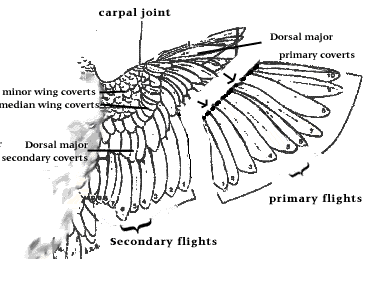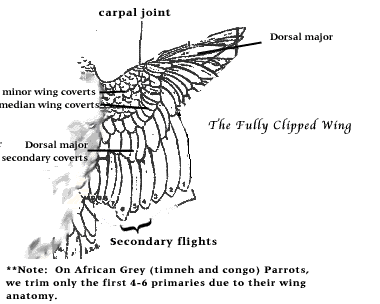Prairie Rose Ranch | home
Babies & Proven Breeders Available | Baby Parrot Prices | Breeder Parrot Pictures | The Nursery | Unweaned Babies | Why Parrots Bite ! | Parrot Recipes ! | Household Dangers & Emergencies | Wing Clipping | Sulphur Crested Cockatoos | Links
Wing Clipping
Keeping your parrot's wing's properly trimmed is an essential part of owning a parrot. Not only does it aid in keeping you, the owner, as the dominant member of the bird-human relationship, it is very important for the safety of your pet. The vast majority of "lost bird" reports come from people who claim to never have clipped their bird's wings, or to have "forgotten" to do this. Even birds who owners claim "never even attempt to fly" are prone to a startle reflex when suddenly frightened. In this case even a handraised bird's instincts tell then to attempt to fly off. If the bird's wings are clipped, the parrot will flutter harmlessly to the ground - if not, this act of owner negligence could result in the loss of a bird.
Even birds who never go outside benefit from clipped wings. A fully flighted bird in the house is much more prone to wing, head and leg injuries resulting from crashes into doors, walls, ceiling fans, windows, mirrors, etc. Sometimes these injuries could prove fatal! Further, a clipped bird is more likely to act dominant to its owner, since it knows it can fly away to a high, "superior" spot if it needs to assert itself.
For those feeling pity for stripping our feathered companions of their unique and beautiful flying ability, fear not. Any bird will learn very quickly to get what it wants using their two wonderfully adapted feet and that marvelous hooked beak. Think about it this way, in the wild, birds fly (expending lots of time and energy) to find food, shelter, safety, things to play with, places to bathe, and companionship. In a proper human-parrot home, all of these things are provided in abundance. If let out of the cage often, and offered plenty of opportunity and variety of food, playthings and companionship, a pet bird with clipped wings will be perfectly content and will never attempt to fly (unless startled).
There are a few different styles of feather clipping. The first ones mentioned are not the ones I recommend! They were designed more for aesthetics and can provide a true false sense of security. The first is called a Window Clip. This means that the two outermost flight feathers (see diagrams below) on both wings are left uncut, and the next 8 or so are cut. It gives a bird a more "wild" appearance. However many birds, especially aerodynamic types like Conures, Macaws, Parakeets and Cockatiels, can still fly with this cut! The next common style is the Single Wing Trim. This is a full cut of only one wing. With this trim, birds can get lift and propulsion on only one side. As a result some birds may fly in circles, which could result in severe injury. I also do not recommend this clip as the bird may injure itself! Another common trim is an Every Other Feather trim. In this case, every other flight feather is cut. This gives the bird a totally wild look, but in many cases does not restrict their flying ability, as a result it can be very dangerous!
The wing trim recommended by me is the Bilateral Wing Trim. With this style, the first 8-10 primary flight feathers on both wings are trimmed to the point of the dorsal major primary coveret feathers. This is a safe cut because you will not hit a blood feather if done correctly. The following diagram describes the method and logic to this trim:
The feathers we are most concerned with when trimming a bird's wings are the Primary Flight Feathers and the Secondary Flight Feathers. The Primary Flight Feathers are the long feathers at the outermost portion of a bird's wing. The provide provide forward propulsion. The Secondary Flight Feathers are those feathers between the Primaries and the bird's body. They provide lift.
When we trim the first 8-10 flight feathers ( on some parrots, like African Grays, only cut the first 6 flight feathers), we are cutting away the primaries. This takes away the bird's forward flight propulsion. Without this, the "lift" part of the flight system is fairly useless. So, if the bird tries to fly away, he will flutter safely to the ground, without falling too hard.
When trimming your bird's wings always aim the scissors away from the bird's body. Otherwise, serious injury could result. Also, be sure to have someone competent holding the bird. You could easily get bit or even strangle your bird if your holder is not careful.
When you cut your bird's primary flight feathers, use the dorsal major primary coverts as a type of "dotted line" guide. These are the smaller feathers just above (towards the bird's head and wrist) the primary flights. If you cut just below (towards the tail) these feathers, you should never accidentally cut an immature or "blood" feather, which could result in pain and bleeding. Normally, the part of the feather sticking beyond the coverts is mature and without blood supply. be very careful when doing this.
Clipping the wings in this manner can be as painless as cutting hair. Usually, the bird has more objection to the restraint involved than the actual wing trimming. As shown in the diagram, when the wing is fully extended, we can see the area cut. However, once the wing is pulled back into a folded position, the cut portion folds under the secondary flight feathers and cannot be seen.
NOTE: If you accidentally cause your bird to bleed during a grooming procedure, do not panic! Bleeding can be stopped by using a styptic powder (i.e. "Kwik-Stop") or even baking flour.

